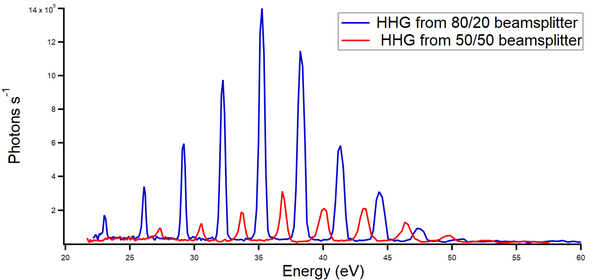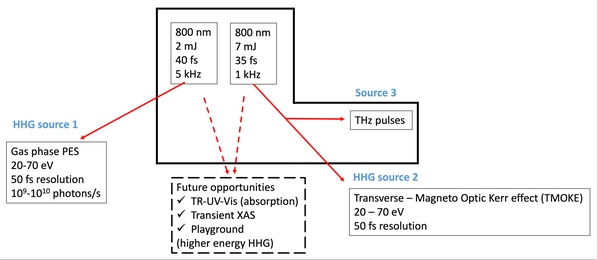HELIOS – High Energy Laser Induced Overtone Source

In the HELIOS laboratory we are studying the temporal evolution of electronic excitations induced by optical excitations. These experiments are typically called time-resolved or pump-probe experiments.
About HELIOS
In a pump-probe experiment, first an optical pump-pulse (typically a laser) is used to perturb a sample into an excited state. Thereafter, a second photon-pulse is then used to probe how the initial perturbation has developed. This is achieved by probing at different times after the initial excitation. Much of the high-time-resolution pump-probe spectroscopy in the world today is (and has been) using two laser pulses which in turn gives extremely high temporal resolution.
In the HELIOS laboratory we have chosen a slightly different path. We use commercial lasers (pulsed with < 35 fs pulse duration) to generate ultrashort pulses of Extreme Ultraviolet radiation (XUV) as a probe pulse. This whole technique is called High Harmonic Generation (HHG) and leads to a XUV pulse of about < 20 fs.
The XUV photons produced at HELIOS have a tremendous advantage over “traditional laser light”, namely their energy, which is in the region of 20 eV to 72 eV. This allows for the probing of shallow core levels of materials so we can see how the constituents of the material change with time after pumping as well as the valance band of the material.

Current status
Today HELIOS includes three working setups. We generate XUV photons on a daily basis and we have shown that the pump-probe aspect of HELIOS is working as expected.
We aim to cover a vast array of experimental fields, including
- Ultrafast magnetization dynamics
- Photophysics and photochemistry of gas-phase molecules
- THz pump-probe spectroscopy
HELIOS accommodates three types of experimental setups. The first is based on XUV reflectometry, which is used for studying ultrafast magnetic dynamics. The second uses a magnetic bottle time-of-flight spectrometer for time-resolved photoelectron spectroscopy. The third generates THz pulses for THz excitations or THz spectroscopy.
Below we show a figure of typical high harmonic spectra.

Below a schematic drawing of the entire experimental setup is shown.

People
HELIOS is a powerful lab used by many researchers in the division; however, there is a core team of members which are more dedicated to the operation of HELIOS as an experimental facility. Below is a list of some of the key individuals involved:
Robert Stefanuik (Research Engineer, main responsible for the HELIOS lab)
Philippe Wernet (Professor in charge of the lab)
Undergraduate students at HELIOS (master projects etc.)
Are you interested in an undergraduate research project at HELIOS? Do not hesitate to contact Robert Stefanuik. Below is a list of ongoing and completed projects at Helios:
Frida Bäfverfeldt
Ultrafast XUV pump-probe photoelectron spectroscopy measurements of solids and gases (work in progress)
Paul Froemel
Implementation of a T-MOKE setup for transient studies of magnetic materials at the HELIOS XUV photon source
Guillaume Fle
Extending the pump energy range for a pump-probe system using High Harmonic Generation
Jonatan Fast
A Numerical Study of the Wavelength Dependence in an Off-Plane XUV Monochromator
Sara Troisi
Testing and First Applications of a Spectrometer for Time-Resolved T-MOKE Measurements (Master's thesis)
If you are interested in working with HELIOS, either as a researcher or student do not hesitate to contact Robert Stefanuik or Philipe Wernet. If you are in the vicinity of Uppsala, you can also visit the HELIOS lab at Ångström – house 6 floor 0.
Publications
2021
- Optical and extreme UV studies of spin dynamics in metallic and insulating ferrimagnets, H. Liu, R. Knut, S. Saha, R. S. Malik, K. Jatkar, R. Stefanuik, J. Söderström, J. E. Shoup, Durga Khadka, T. R. Thapaliya, S. X. Huang, A. Gupta, O. Karis, D. Karaiskaj, and D. A. Arena, Journal of Applied Physics 130, 240901 (2021)
- Ultrafast magnetization dynamics in the half-metallic Heusler alloy Co2FeAl
R. S. Malik, E. K. Delczeg-Czirjak, R. Knut, D. Thonig, I. Vaskivskyi, D. Phuyal, R. Gupta, S. Jana, R. Stefanuik, Y. O. Kvashnin, S. Husain, A. Kumar, P. Svedlindh, J. Söderström, O. Eriksson, and O. Karis, Phys. Rev. B 104, L100408 (2021) - Element-Specific Magnetization Dynamics in Co–Pt Alloys Induced by Strong Optical Excitation, Igor Vaskivskyi, Rameez Saeed Malik, Leandro Salemi, Diego Turenne, Ronny Knut, Jeffrey Brock, Robert Stefanuik, Johan Söderström, Karel Carva, Eric E. Fullerton, Peter M. Oppeneer, Olof Karis, Hermann A. Dürr, J. Phys. Chem. C 2021, 125, 21, 11714 (2021)
2020
- Analysis of the linear relationship between asymmetry and magnetic moment at the M edge of 3d transition metals, Somnath Jana, R. S. Malik, Yaroslav O. Kvashnin, Inka L. M. Locht, R. Knut, R. Stefanuik, Igor Di Marco, A. N. Yaresko, Martina Ahlberg, Johan Åkerman, Raghuveer Chimata, Marco Battiato, Johan Söderström, Olle Eriksson, and Olof Karis, Phys. Rev. Research 2, 013180 (2020)
2018
- Developments and enhancements to the HELIOS pump probe system
Robert Stefanuik, Ronny Knut, Somnath Jana, Joachim A. Terschlüsen, Anders Sandell, Johan Söderström, Journal of Electron Spectroscopy and Related Phenomena 224, 33 (2018)
2017
- A setup for element specific magnetization dynamics using the transverse magneto-optic Kerr effect in the energy range of 30-72 eV, Somnath Jana, Joachim Andreas Terschlüsen, Robert Stefanuik, Stefan Plogmaker, Sara Troisi, Rameez S. Malik, Mathias Svanqvist, Ronny Knut, Johan Söderström, Olof Karis, Review of Scientific Instruments 88 (3), 033113 (2017)
2016
- Constructing and Commissioning HELIOS – A High Harmonic Generation Source for Pump-Probe Measurements with sub 50 fs Temporal Resolution: The Development of Experimental Equipment for Extreme Ultraviolet Spectroscopy, Doctoral thesis – Joachim A. Terschlüsen
- Electronic structure dynamics in a low bandgap polymer studied by time-resolved photoelectron spectroscopy, Phys. Chem. Chem. Phys., 2016,18, 21921-21929, Ute B. Cappel, Stefan Plogmaker, Joachim A. Terschlüsen, Torsten Leitner, Erik M. J. Johansson, Tomas Edvinsson, Anders Sandell, Olof Karis, Hans Siegbahn, Svante Svensson, Nils Mårtensson, Håkan Rensmo and Johan Söderström
2015
- HELIOS—A laboratory based on high-order harmonic generation of extreme ultraviolet photons for time-resolved spectroscopy, Rev. Sci. Instrum. 86, 123107 (2015); http://dx.doi.org/10.1063/1.4937463
S. Plogmaker, J. A. Terschlüsen, N. Krebs, M. Svanqvist, J. Forsberg, U. B. Cappel, J.-E. Rubensson, H. Siegbahn and J. Söderström
2014
- Measuring the temporal coherence of a high harmonic generation setup employing a Fourier transform spectrometer for the VUV/XUV
Nuclear Instruments and Methods in Physics Research Section A, Volume 768, 21 December 2014, Pages 84–88, J. A. Terschlüsen, M. Agåker, M. Svanqvist, S. Plogmaker, J. Nordgren, J.-E. Rubensson, H. Siegbahn, J. Söderström
2012
- Techniques and Application of Electron Spectroscopy Based on Novel X-ray Sources, Doctoral Thesis – Stefan Plogmaker
Contact
- Head of Division
- Nicusor Timneanu
